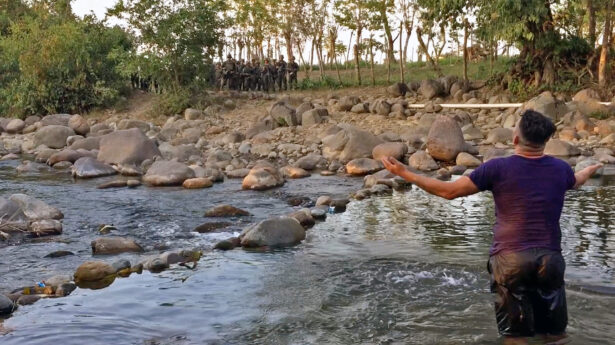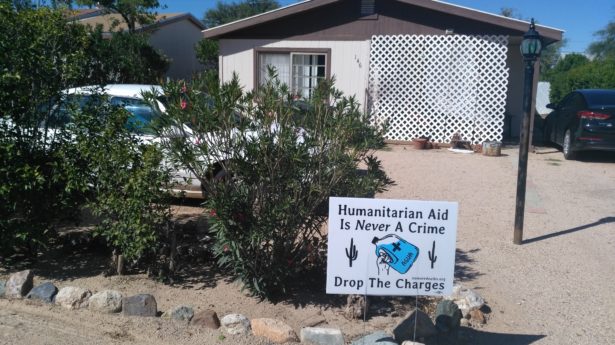The Unitarian Universalist Service Committee advances human rights through grassroots collaborations.
The Ways Water Weaves the World
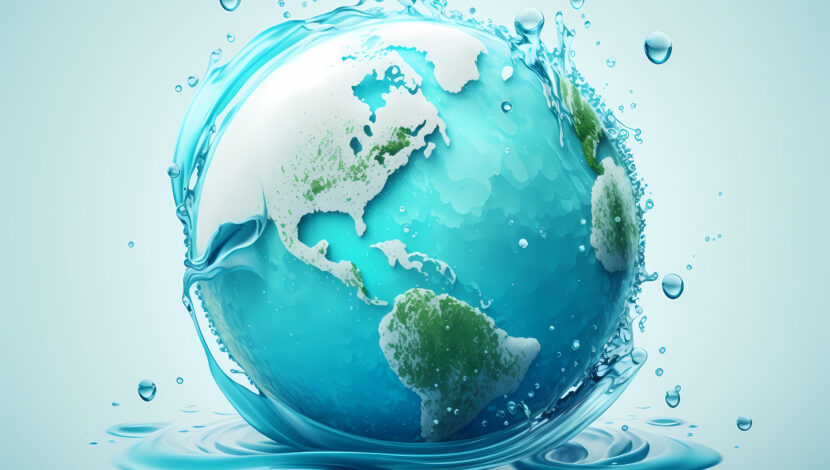
April 18, 2023
Table of Contents
- Guapinol: The Camapign for Clean Water Continues
- Earth Day Interview: Solomon Islands—Solomon Yeo
- Earth Day Interview: Kioa Island—Maina Talia
- Earth Day Interview: Tuvalu—Richard Gorkrun
- Earth Day Interview: Marshall Islands—Kathy Jetn̄il-Kijiner
- Water on Rabi Island
- Water Crisis: From Philadelphia to Guapinol
- Replenishing Resources: More Facts About Water and its Importance
- Introduction: The Ways Water Weaves the World
Guapinol: The Camapign for Clean Water Continues
UUSC continues to support the water defenders of Guapinol, Honduras who have resisted government and private sector attempts to further destroy their water systems through iron ore mining.
In 2019, eight Honduran men were arrested by their government for attempting to defend the Guapinol River from extraction and pollution. The river, which is critical for accessing clean water in the communities through which it runs, has been polluted to the point of turning “the color of chocolate” at the hands of the Inversiones Los Pinares (ILP) mining company. The ILP mines iron oxide along the river, polluting it and endangering the community by severely reducing members’ access to safe water. In response, the Guapinol community organized a camp along the river, physically preventing the ILP from continuing to mine. As a result, the Guapinol Eight—composed of Daniel Márquez, Kelvin Romero, Arnol Aleman, Abelino Cedillo, Ewer Cedillo, Porfirio Sorto, Orbin Hernández, and Jeremias Martínez—were arrested by the Honduran government, which used tear gas and live ammunition to disperse the camp. The men were released from detention in February 2022 due to international pressure.
Today, the community of Guapinol continues to defend the river through organization and mobilization. Here’s a look at some of the organizing currently happening in Guapinol in defense of water.
April 17 Tocoa March
Protesters most recently took to the streets in the nearby town of Tocoa where the ILP office is. The protest took place on Monday, April 17 in honor of International Day of the Farm Worker. The day commemorates the 1996 murder of 19 Brazilian farmers at the hands of the military as they protested inequality in the country.
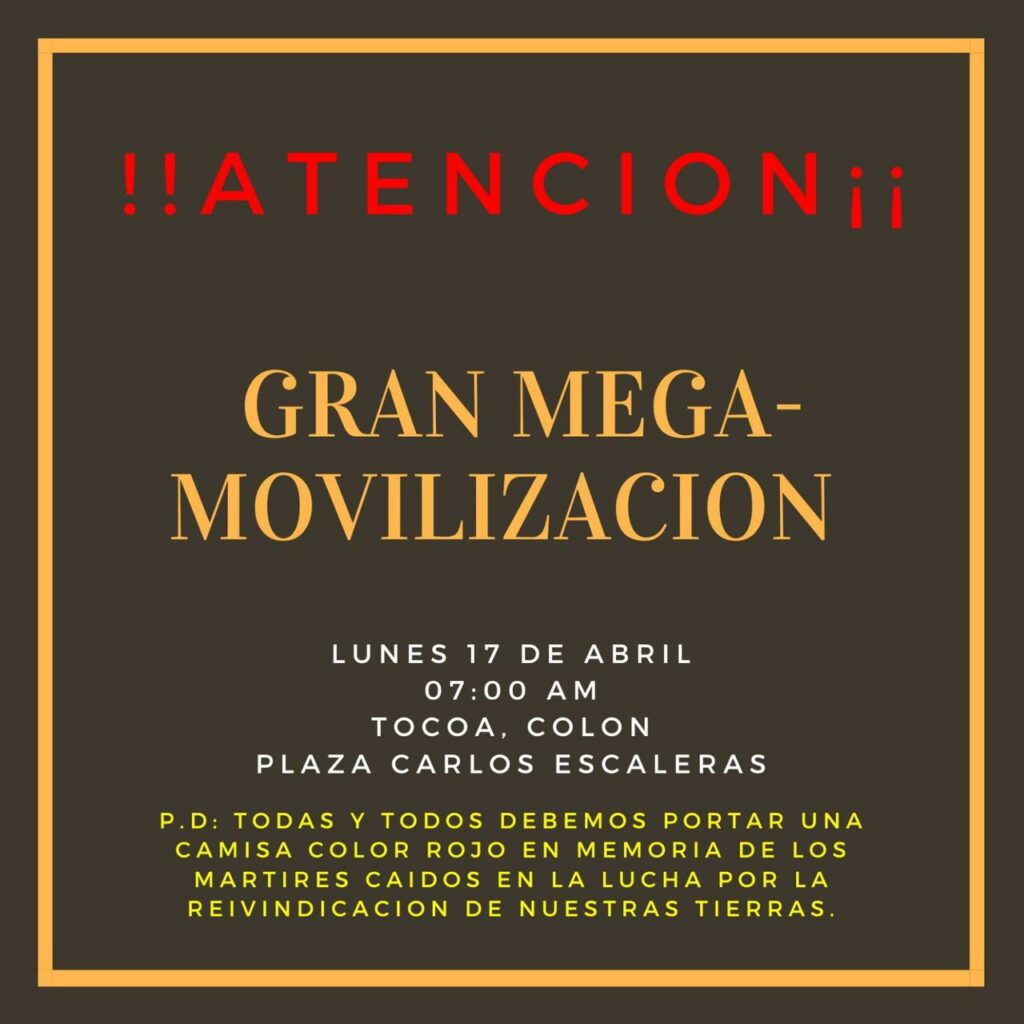
A flyer circulated on WhatsApp to advertise the march.
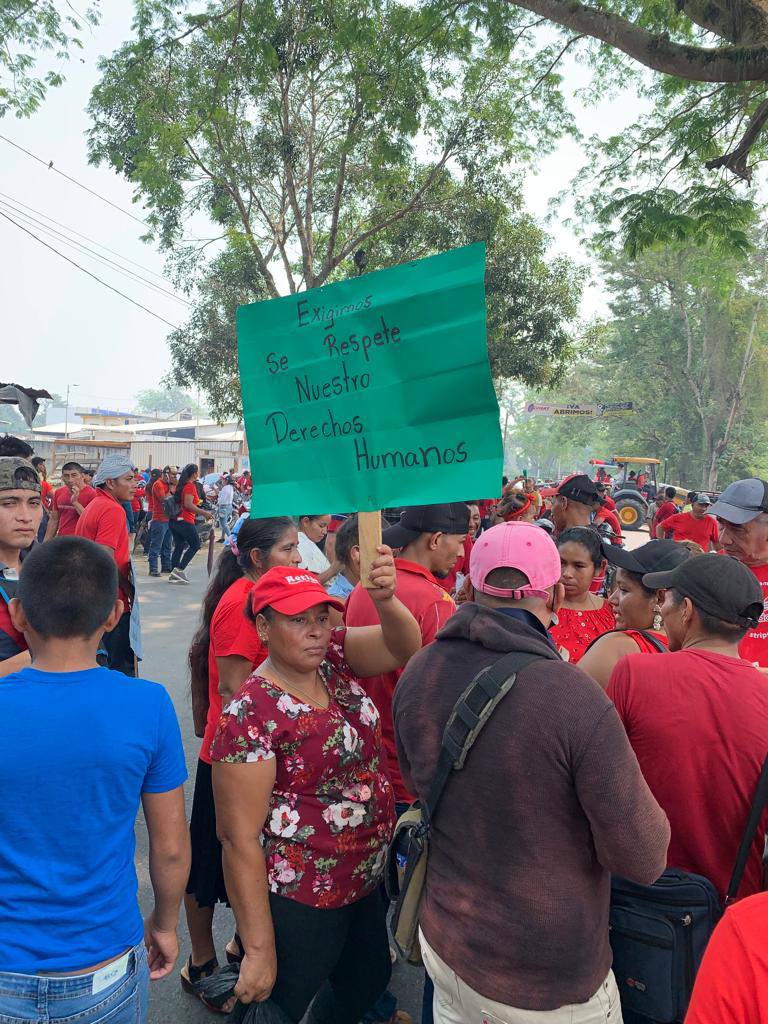

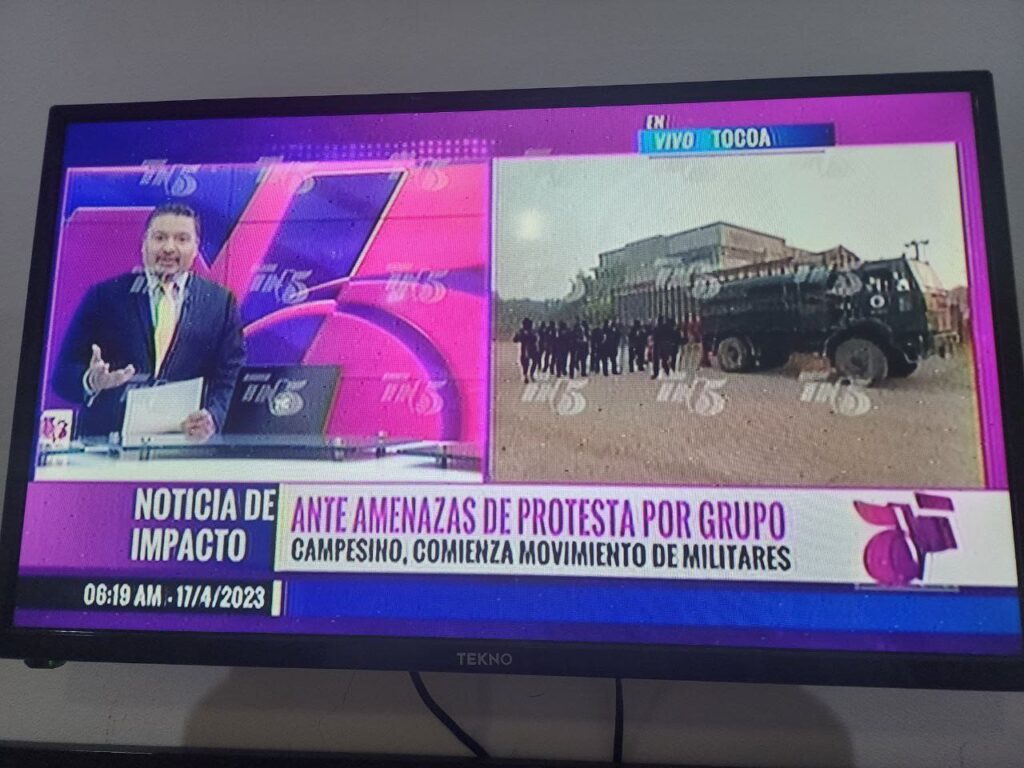
March Protests in Tocoa
In March, the Guapinol defenders organized a separate march in opposition to the mining company in Tocoa.
Protesters called for a mass mobilization to reject mining exploitation and in demand for the immediate cancellation of the ILP’s illegally obtained license.
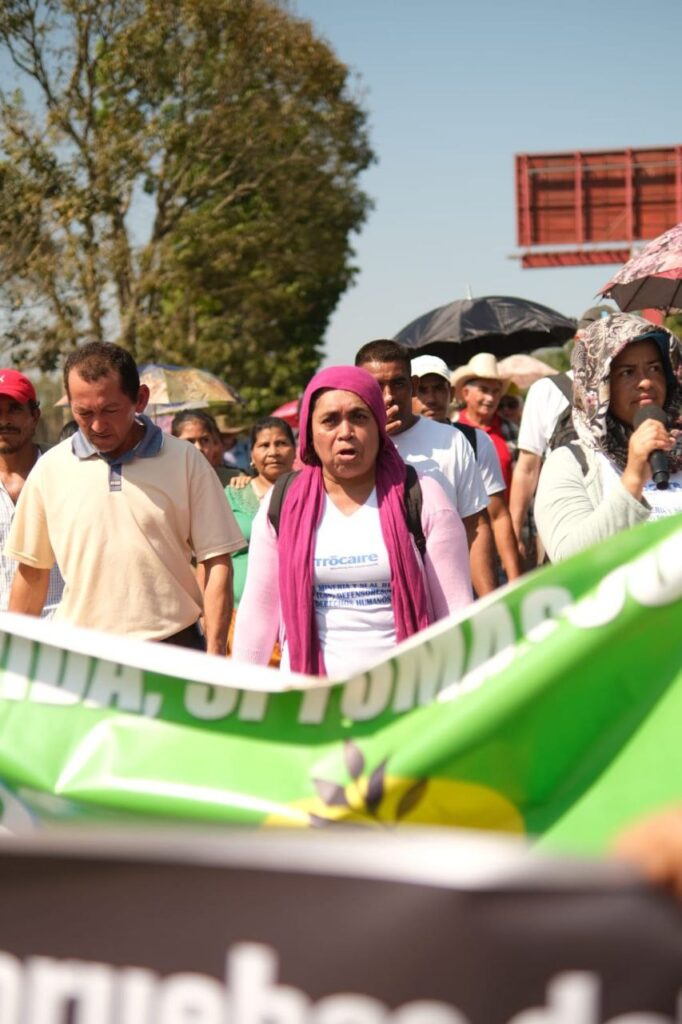
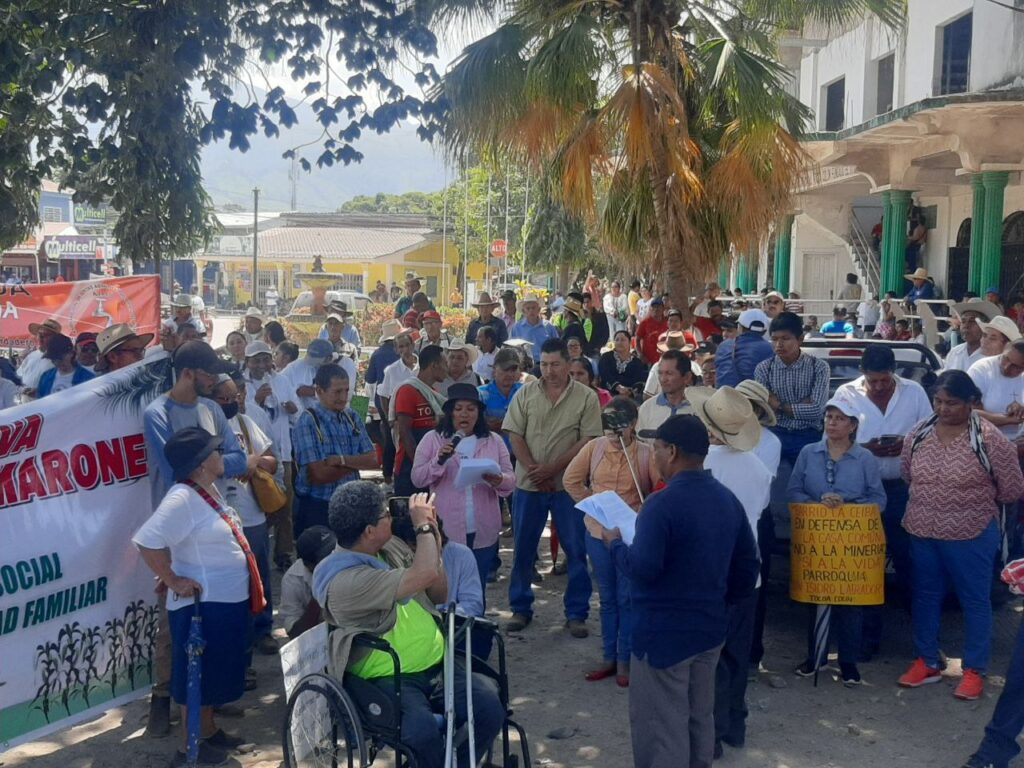
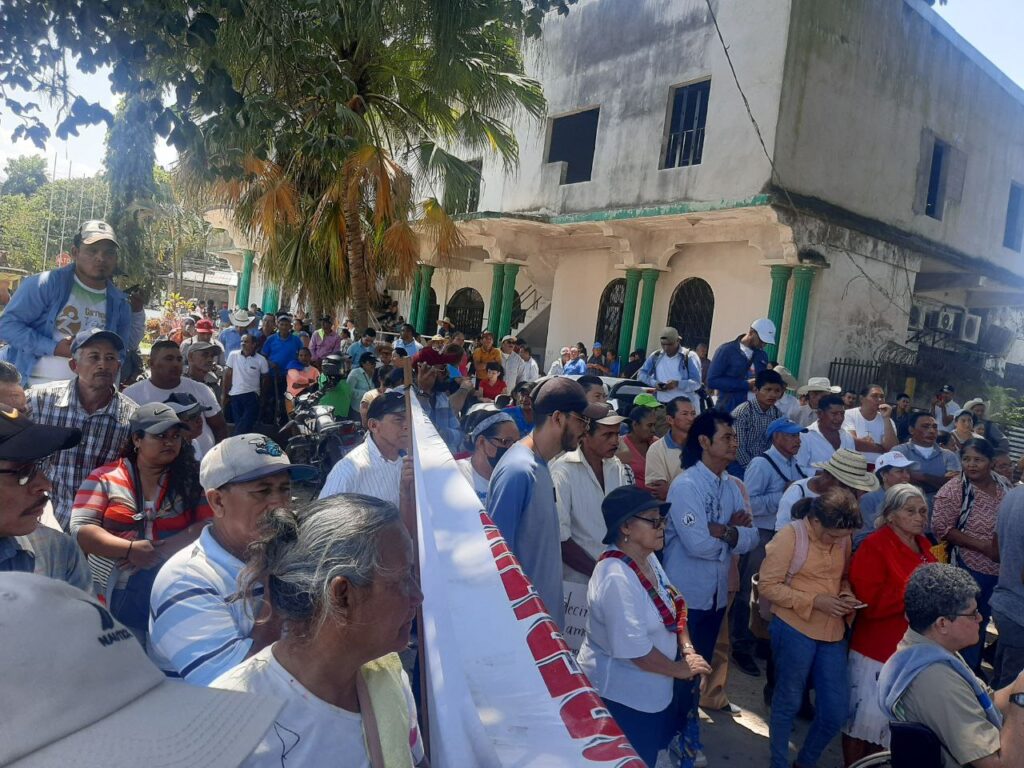
Reynaldo Dominguez with SHARE
Currently, Reynaldo Dominguez, who has also been detained for protecting the Guapinol waterway, is in the United States as part of a larger tour organized by the SHARE Foundation, an El Salvador-based social justice organization that has committed to supporting the Guapinol water defenders. During the tour, Reynaldo will be doing talks in several cities as well as legislative visits in Washington D.C. focused on the defense of water, land, and the Guapinol community.
Earth Day Interviews
Our planet is extraordinary, but it needs our help to thrive. That is why each year, on April 22, we celebrate Earth Day and bring a greater awareness of climate events that impact our planet, such as pollution, deforestation, and fossil fuels. It’s time to recognize the severe challenges posed by climate change.
We know how climate change is impacting our oceans and coastal resources. And that is why this week before Earth Day, we will focus on a series of interviews with our partners from the Pacific Islands.
Solomon Islands—Solomon Yeo
The Solomon Islands, just like many other Pacific countries, is vulnerable to climate change, tropical cyclones, and constant flooding. The islands are also affected by saltwater intrusion, which affects the drinking water for many communities. Low-lying islands in the Solomon Islands are at the forefront of climate change and injustice. These environmental changes have impacted community health, poverty, and forced migration.
Pacific Island Student Fighting Climate Change (PISFCC) is a youth-led organization, and the members are students from Pacific Island countries. PISFCC began with law students from eight different Pacific Island countries who decided to join together and persuade the leaders of the Pacific Island Forum to take the issue of climate change and human rights to the International Court of Justice (ICJ).
Solomon Yeo is the campaign director of the PISFCC. Yeo is an activist from the Solomon Islands, working alongside civil society and youth to advance Pacific climate justice. He was also one of the 26 law students who founded the PISFCC.
Kioa Island—Maina Talia
Kioa Island is located in Fiji and its communities are working to establish a secure footing and resilient future for generations by improving agriculture and access to fresh water. Kioa Island Community Organization (KICO) is helping to execute this vision.
KICO has helped the Kioa communities to become more climate resilient. They are working toward this goal by training the community members in agriculture, helping to create leadership, and seeking community input.
Maina Talia is from Tuvalu and has recently completed his doctoral studies at Charles Sturt University in Sydney. In this interview, Talia talks about the dangers climate change brings to Pacific nations and how larger nations can help the small island developing states
Tuvalu—Richard Gorkrun
Richard Gorkrun is a former meteorologist and the current executive director at the Tuvalu Climate Action Network (TuCan). Gorkrun shares his concerns about the island’s potential fate as global warming worsens.
Tuvalu has always fought extreme weather events such as floods and storms. However, in recent years, climate change is making it slowly inhabitable. For the communities on the island, a healthy ecosystem is important because agriculture is their primary source of economic and dietary welfare.
Learn more about the unique experience of Tuvaluans as they experience the impacts of climate change.
Marshall Islands—Kathy Jetn̄il-Kijiner
Just like other atoll nations in the Pacific that suffer from climate change, the Marshall Islands are not an exception. A study conducted by the World Bank predicts that 96 percent of Majuro, the Marshall Islands’ capital, is at risk of frequent flooding induced by climate change. It has also been projected that by 2035, some of the Marshall Islands will be submerged. And others will no longer have drinking water due to saltwater contamination, which results in forced migration.
Jo-Jikum is a nonprofit organization that supports the next generation of Marshallese people to navigate and develop solutions for their islands impacted by pollution, climate change, and nuclear legacies. Kathy Jetn̄il-Kijiner is a climate envoy for the Marshall Islands and Jo-Jikum’s co-founder and director. She is also a poet and performance artist from the Marshall Islands. You can find some of her works here.
Water on Rabi Island
Acknowledging the progress made towards Te Mwenga’s most recent Motawa Water Security Project.
Rabi Island in Fiji is home to the largest population of Banaban people outside of Banaba Island in Kiribati. Te Mwenga, a Fijian organization, works with the community to ensure Banabans and Banaban culture are protected and able to flourish on Rabi Island.
Water is the most valuable resource in the world. People around the globe use water every day to cook, clean, pray, and hydrate themselves, and therefore require unrestricted access to clean, safe, and reliable water sources as a human right. In February 2023, Te Mwenga implemented the Motawa Water Security Project on Fiji’s Rabi Island to ensure residents of the Tabwewa Village have continuous access to this critical resource.
The water project, which was supported by UUSC, included the installation of a water tank that reduced residents’ need to “walk, paddle, or swim over a kilometre for their daily water needs,” as reported by the Fiji Sun. Through the project, Te Mwenga resists the deleterious effects of climate change on the island. The Fijian archipelago is one of the areas of the world most affected by climate change, with effects endangering food and water security among other ways of life. In addition to clean drinking water, the Motawa Water Security Project will also allow residents to “build toilets and embark on economic activities to contribute to their development in terms of tourism and agriculture.”
Te Mwenga, also known as the Banaban Women’s Organization, was established in 1968 to foster women’s socio-economic, spiritual, cultural, and political development. The organization also contributes to ensuring that Rabi Island remains a home for the Banaban people and culture. In 1945, following the Second World War, the British Phosphate Company (BPC) that was jointly owned by the United Kingdom, New Zealand, and Australia displaced thousands of Banabans from their homes on the island (now part of Kiribati). Today, more Banabans live on Rabi Island than on Banaba as the island is nearly completely uninhabitable.
After 80 years of extraction, the BPC removed over 44 billion pounds (22 million tons) of land from the island and stripped about 90% of its surface bare. In addition, mining destroyed the island’s natural cave system, te bangabanga, that residents historically relied on for clean, drinkable water in periods of unreliable rainfall. As such, the individuals who have remained on the island are reliant upon a water desalination plant that has proven to be an unsustainable solution.
Today, Te Mwenga serves as a champion for the Banaban community on Rabi Island. The organization partners with Rabi Council of Leaders, village chairmen from the four villages of Rabi, the Rabi Island Community Hub (RICH), youth and women’s groups, and the communities of Rabi. Their work is informed by scientific research, consultations, data collection, and most importantly it centers their traditional knowledge, wisdom, and practices for building climate adaptation and resilience.
Te Mwenga has partnered with UUSC since 2022 to address Rabi’s worsening environmental crisis, support frontline Banaban communities with their loss and damage work, strengthen the capacity of the Rabi Island Community Hub (RICH) and help the organization become a registered NGO that will connect the communities with partners to deliver results and protect the people and the culture of the island. Te Mwenga supports the creation of healing spaces for Banabans that have survived with personal and generational grief and trauma.
UUSC will continue to support organizations like Te Mwenga that develop sustainable solutions to environmental and ecological crises while simultaneously supporting the strengthening of culture and community.
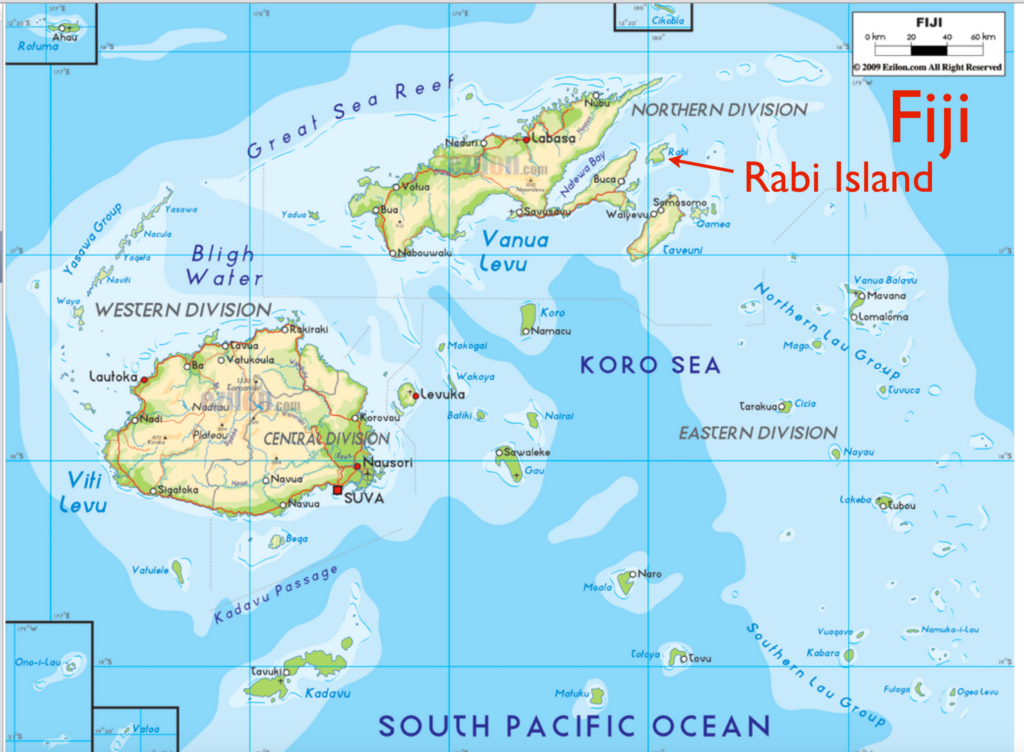
Water Crisis: From Philadelphia to Guapinol
The recent water crisis in Philadelphia serves as a stark reminder that water and land issues are not just a concern for distant international communities like those in Guapinol, but for all of us in the United States. The chemical water spill in Philadelphia and the disastrous train derailment in East Palestine, Ohio have shown how vulnerable our water infrastructure can be, as we have already surpassed 50 incidents resulting in chemical spills or fires around the United States in 2023, according to the Coalition to Prevent Chemical Disasters. These incidents remind us that we cannot afford to turn a blind eye to international water and land issues, as the depletion of our infrastructure could become all too real in an instant.
While mining operations and government corruption have driven the water crisis in Guapinol, the U.S. incidents reveal that similar threats to our water supply can come from industrial accidents, equipment failures, and failure from government oversight/maintenance. Both crises highlight the need for stronger regulations and greater accountability to ensure the safety and sustainability of our water resources. If we truly care about safeguarding our water supply and protecting all communities, we must first recognize the interconnected nature of these issues and work towards global, sustainable solutions.
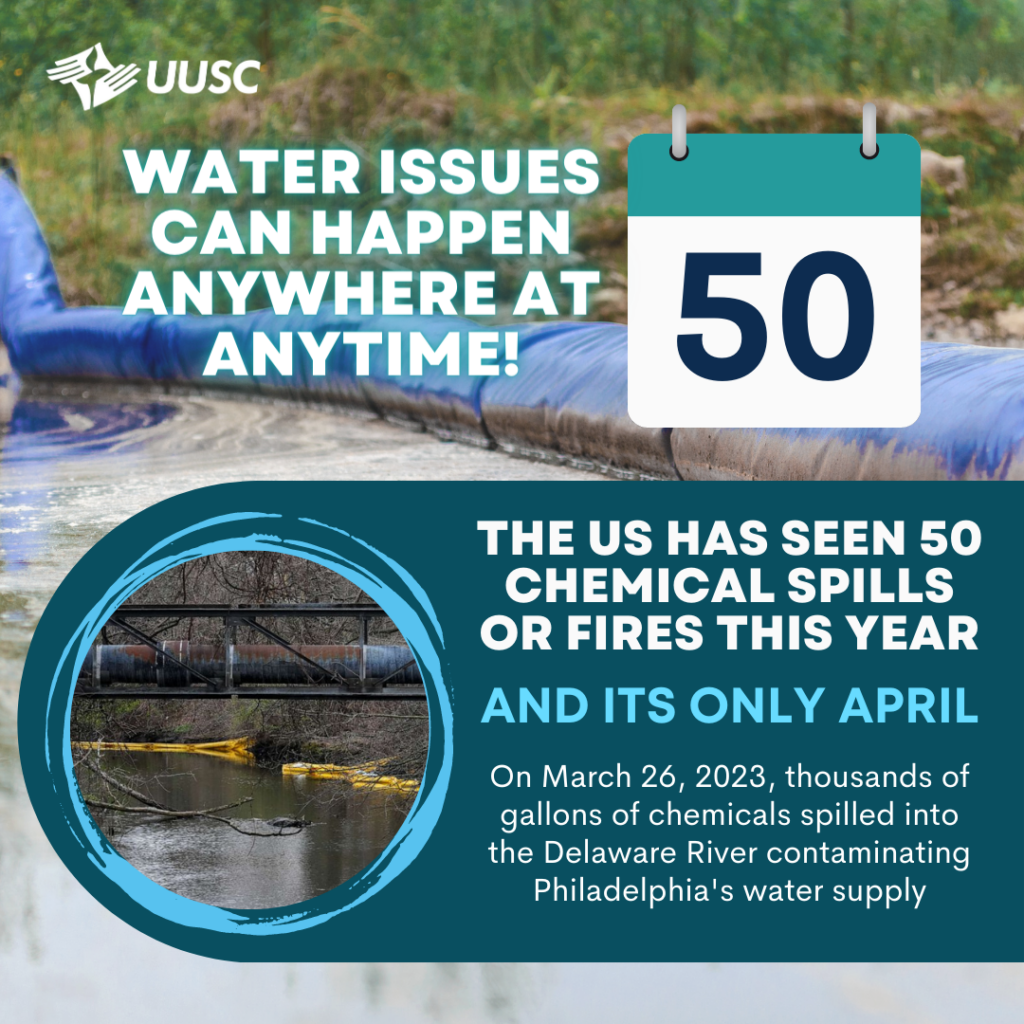
Replenishing Resources: More Facts About Water and its Importance
People around the world celebrate Earth Day—the anniversary of the beginning of the modern environmental movement—every year on April 22, and we’re taking part too.
Even though the official theme of Earth Day this year is “Invest In Our Planet,” we here at UUSC have decided that our focus this year will be water.
We’ve come across a variety of resources while creating the content we’ll publish throughout Earth Week. All of what we’ve learned has informed us, some has startled us, and some more has inspired us, and we wanted to share a curated collection of those resources with you.
Below is a completely incomplete list of things to read, look at, watch, and listen to as you explore the life-giving element of water with us.
Resources about water to look at and read.
Below you will find articles, visuals, a report, and a book about water.
Humans care where we come from, and floods have provided the main backdrop to many of the most important emergence stories from cultures and religions around the globe. From the story of Noah’s Ark to the story of Yu the Great, origin legends of great floods know no bounds and have helped our species define ourselves.
[Interactive App] River Runner
Have you ever wondered what happens to a raindrop when it falls? This interactive visual by Sam Learner uses United States Geological Survey data to show you the journey of a droplet into main bodies of water.
[Infographic] Water Cycle Diagrams
These diagrams from the United States Geological Survey show two versions of how water cycles through the environment: the natural cycle and the cycle that includes human interventions and infrastructure.
[Article] Mní wičóni
Mní wičóni is a Lakota way to say “water is life.” The sentiment went worldwide during the Standing Rock protests, but it has been around for centuries. We hope that this reverence towards water is adopted by more people now and remains for innumerable centuries to come.
This is a story about the Colorado River, droughts, climate change, the concept of legal rights to water, present-day Tribal leadership, and the sacrifices people make in attempts to dominate nature to survive.
A perspective from a Korean American that examines her ancestral past that is steeped in colonialism and conservation of resources. The piece reminds us to listen to voices that may not typically be the loudest in the room.
[Article] Microplastics in the water
Plastics from fossil fuels degrade over time, but they never go away. Instead, they break down into microplastics. These bits of plastic are smaller than popcorn kernels, and you can now find them in every ecosystem on Earth.
[Report] 2022 Sea Level Rise
Several government agencies collaborated to produce projections for sea level rise through the year 2150 for all U.S. coastal waters and published that information in a technical report. Here are the four key takeaways:
- They project that the sea level along the U.S. coastline will rise as much in the next 30 years as it did in the last 100 years;
- This sea level rise will contribute to stronger storm surges and much more frequent flooding along the coasts—more than 10 times as often compared to today;
- A failure to curb future emissions could more than double the expected amount of sea level rise; and,
- Ongoing and expanded monitoring will be critical as sea levels continue to rise.
[Book] Rising by Elizabeth Rush
A deeply felt description of communities along the U.S. coastline, Rising: Dispatches from the New American Shore by Elizabeth Rush makes sea level rise feel personal.
[Article] America’s Wetlands
Marshes, swamps, wet grasslands, and mangroves are biologically diverse, ecologically critical, and among the most fragile ecosystems on Earth. In the United States, more than half of the wetlands that existed prior to European colonization are gone due to anthropogenic climate change. Learning about these wetlands—and visiting them as responsibly as you can—is another step you can take towards protecting them from complete collapse.
Content about water to listen to and watch.
Settle in for these videos, documentaries, and a podcast about water. To start, let’s listen to a famous Gospel song with a modern twist.
[Video] Wade in the Water: Live
Social and environmental justice movements can be fueled by music. Jubilee songs like Wade in the Water were created by enslaved Black people. Their parents and grandparents were tormented by the waters of the Middle Passage, but water never lost its healing powers for people striving for their spiritual and physical liberation. This modern rendition of Wade in the Water by The Spirituals might give you chills.
[Video] Explained | World’s Water Crisis
3 out of 10 drops of water on Earth are fit for consumption, but 2 in 3 of those drops are either frozen or inaccessible to species that need freshwater (like humans). How we care for that remaining drop of water can determine the fate of our communities, other beings, and without exaggeration, our species. This episode of Explained looks at the state of the global freshwater supply.
[Documentaries] Fascinating water situations
It’s not always easy to comprehend and explain the effects of things like “deforestation” or “ocean acidification.” These two films will bring you into the know and equip you with a story or two to share with others about these complex processes.
[Documentary & Videos] The U.S.’s water systems
A sizable amount of the funding for international freshwater projects comes from the United States., but there is still plenty of work to do—and undo—domestically. Below are three documentaries and videos that look at a variety of water issues in the United States created by systemic racism, corporate greed, government inaction, mismanagement, overconsumption, or all of the above.
[Documentary] Lessons of the Loess Plateau
Human-created ecological problems can often be solved by nature-led approaches. That’s the story of The Loess Plateau. It was the cradle of civilization in China before human extraction from the land turned the lush landscape into a desert. Creating the hydrocycle brought it back.
[Podcast] How to save a planet
Late in 2022, the #1 podcast about climate change (and what each individual could do to address it) was canceled by Spotify. This podcast inspired many of us to change our behaviors and to share our compassion for the planet with others, but advertisers didn’t find it commercially viable enough. We see this as an example of the misalignment that can exist between current ambitions of corporations and the needs of Mother Earth.
The poetry of water
Water is a poetic element. Every drop of water here today arrived 4 billion years ago when frozen asteroids bombarded the Earth, and those drops have never left. The water that circulates within you has circulated through a plant on the opposite side of the world, the river that flows 100 miles away from you, the soil that grew the food that transformed into your meal yesterday, and through every person you love and despise.
Below is a small collection of poetry that expresses the different powers and cultural comprehensions of water. Please be warned that some of the content below contains honest-yet-explicit content.
[Watch & Listen] After Sacred Water
Kinsale Hueston recites a poem about the pollution of simpler, more sacred Diné waters.
[Watch & Listen] Water
Porsha Olayiwola addresses a charged question: “Why do Blacks possess the fear of water?”
[Watch & Listen] When the Water is Gone
Rudy Francisco reflects on the endlessness of water and wonders if his grandkids will have any water left.
[Watch & Listen] Water Does Not Exist Here
Symone “Brielle” Johnson-Hawkins speaks on how the weaponization of water can make it seem as if it doesn’t exist.
[Watch & Listen] To Make Use of Water
Safia Elhillo demonstrates the reality of cultural dilution through a metaphor of water.
The conclusion, inspired by water.
We’re focusing on water this Earth Week because we can grasp it easier than we can grasp 1.5°, more than we comprehend high-level policy, and often more than we can understand each other.
All climate issues find their way back to water. When there’s a drought, there’s no water. When there’s an inundation, there’s too much water at once. Water literally connects us with every other being, and those connections make us us.
Mní wičóni.
Introduction: The Ways Water Weaves the World
On April 22 every year, we celebrate the birth of the modern environmental movement in 1970.
People around the world take a moment to think about our role on this planet, engage in actions to protect the environment from our actions, and work to get the attention of politicians and corporate leaders who have power to make changes at a large scale.
Each Earth Day has a theme, and this year’s theme is “Invest In Our Planet.” At UUSC, we’re taking that theme and distilling it down to something more specific: water.
We’re focusing on water this week because of our experience working with partners along the coasts of the United States, with people on islands dealing with rapid sea level rise and corporate interests in the Pacific Ocean, with communities defending their water in Central America, and with migrants fleeing genocide through ocean passages and needing water when arriving at refugee camps.
Water connects us in every way, and that’s what we’re communicating this Earth Week.
Here is the water.
The first drops of water landed on Earth 4 billion years ago.
Those drops arrived on asteroids just after the formation of Earth itself, and more drops joined throughout this period of time as frozen asteroids slammed into the new planet. Oceans, lakes, rivers, and polar caps were formed by this bombardment. Life on the planet began and adapted to the new alien lifeform: water.
The original water from 4 billion years ago is still here. The following drops have never left, and none have been created since. The original water is still frozen, in liquid form, and in the atmosphere. The water cycles among those phases. Sixty percent of our body is water, and the original water is still within us.
Taking this into account, we are at least 4 billion years old. The water connects us all. Here is the water, and you are it.
Are “carbon emissions” compelling enough?
Which of the following prompts would lead to some small change in your personal actions?
- You released 217 kg of carbon dioxide into the atmosphere during your last flight from Los Angeles to Atlanta and back.
- The plastic container your salad came in today took more than a gallon of water to create—and that’s not even counting the salad.
Which felt visceral? Which gave you a greater sense of control over the impact you have on the environment? Your answers to these questions may bring awareness to what your current paradigm is about environmental action.
Climates around the world have changed rapidly since industrialization, and we have caused that swift transformation.
For decades, the scientific community–at least the parts of the community unpolluted by denialism and corporate persuasion–—has produced results that clearly show the importance of aggressively decreasing our emissions. Humanity has set a goal of preventing the global temperature from increasing by 1.5° Celsius, mainly by curbing carbon emissions produced by using fossil fuels. While congregations must continue praying that we hit that goal, it will take a miracle to reach it. This goal is a serious goal based on rigorous research.
Unfortunately, “curb your emissions to combat global warming” isn’t the compelling messaging we need for change.
Water cycles, introducing another paradigm to everyday life.
From a narrative change perspective, it may be more important for you and I to appreciate how we impact the flow of water than it is to understand how our carbon emissions contribute to global warming.
Water is near us. It’s in us, it is us, and remember, it’s at least a few billion years old.
This alone makes it easier to communicate to ourselves in a way that impacts our everyday actions. We can use just a little less water during our morning showers. We can choose foods that support the water cycle. We can shop at companies and source from vendors that use less water to create their product and cool their equipment. We can advocate for policies, practices, and placements that work with water cycles instead of against them.
We can also advocate for major adjustments to our mentality and management of water.
When a farmer looks to the sky during a drought, the farmer doesn’t wish for fewer emissions. They wish for rain. When neighbors look at the flooding that followed another historic rainfall, they don’t pray for global cooling. They pray for safety from the water. When the hurricane is on the way, when the wetland turns into ocean, and when the river runs dry—in some way or another—our wishes are about water.
One reason why governmental, systemic, and behavioral changes have been so slow is because we’re too focused on the scientific truth: that severing our dependence on fossil fuels for energy will drastically curb new carbon emissions which will ultimately decrease the global temperature.
The scientific truth always benefits from something more—something more central to who we are. That’s water.
In this series, we will examine how water impacts all of us, from local efforts to access clean water to global efforts to preserve our oceans.
Image Credit: Adobe
